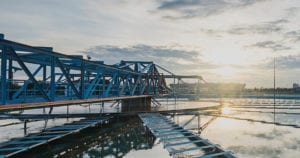This audio was created using Microsoft Azure Speech Services
Today we know that the self-sufficient biological treatment plant is on the horizon. There are many options available to those who need to optimize their treatment plants, but for now I will highlight two key areas on which we can initially focus.
Extensive studies in Germany(there are about 10,200 water treatment plants there) show that, with very little effort, the consumption of electrical energy can be cut by 50 per cent, at the same time as doubling green power generation.
To be able to do this you need to first breakdown the electricity consumed within a water treatment plant.
Aeration accounts for 50 – 60 per cent of the electricity consumed in a water treatment plant. As the largest energy consumer, this is the most likely place to start implementing measures to optimize energy use.
Depending on the current process, the components used and the degree of automation, there are different approaches that need to be investigated in detail. Based on these investigations, optimization measures are derived, and then subjected to further feasibility studies and possible funding options.
In addition green power generation plays an essential role in optimizing wastewater plants. Biogas can be converted into electricity via cogeneration, whereby the waste heat can be used in the plant again. Of course, the size of the treatment plant is a fundamental consideration here. Following the studies in Germany it was found that only approximately 11 per cent of treatment plants have green power generation, however those plants cover about 76 per cent of the population.
I have an example that highlights these ideas in our work with the treatment plant Fritzens, in Tyrol-Austria. Fritzens applied various optimization measures to the aeration of its plant and subsequently increased its green power generation so significantly that the company was able to reverse its energy balance and become a power supplier.
Are you involved with water or wastewater treatment facility? What measures have you taken to optimize energy efficiency in your operations?




Conversation
Christopher Dennen
12 years ago
This is an amazingly effective technology that should undoubtedly be used in more treatment plants. I worked with a water treatment facility in Essex Junction Vermont USA that has been generating about 40% of its total electricity demand this way for about 9 years. We found that the payback for the infrastructure involved with these systems can be as low as 6-7 years. For municipalities this is a great rate considering they generally use their infrastructure for 30 + years. Methane Co-gen is an underutilized resources that can either off-set energy use or feed power back to the grid.
sankalp
12 years ago
its the inspiring new technology to provide services like Water treatment plant, Sewage treatment plant, Effluent Treatment Plant, pharma grade water ..thanks
securedacquawater purification treatment plant
10 years ago
What a great website, i am searching in google from couple of days” but did not find any great way, but my search came to an end after visiting your website.!!!Do you have any more related website or ideas related to like your this post, it will help me in my further research work…Will keep following your website…
kamal mondal
8 years ago
nice article,great work.nice blog.